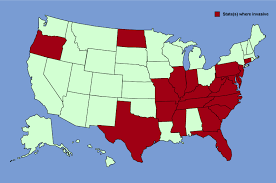This past weekend, I attended a seed exchange along with about 150 other people. I was there as a vendor, selling statuary while most of the attendees came, bringing seeds from their gardens as well as beautiful and well read old gardening magazines and books they could swap for something else to take home to read and pass the wintertime away until the seeds they collected and traded can be planted.
 |
| Looks innocent enough until you find out just exactly what Pueraria lobata stands for! |
Throughout the day, there was quite a large variety of seeds, spread out in orderly fashion among the tables, in little plastic bags and petite paper envelopes for anyone to choose from. My friend, Kim, picked up a nicely packaged seed labeled "Thomas Jefferson Vine"
Pueraria Lobata, and handed me one as well. It certainly sounded intriguing as I know there are several vines and flowers here in Virginia and throughout the country that can be credited to Thomas Jefferson and his travels to Europe, bringing them home to plant in his gardens at Monticello.

Once I got home, I looked up what this particular vine,
Pueraria lobata, really is, and
oh brother, am I glad I did before I ever had the chance to scatter this invasive weed known as Kudzu! That's right--KUDZU!! What in heaven's name would possess a person to bring such an invasive, noxious weed to a seed exchange??? I have a feeling that even Jefferson, himself would not want this particular plant traced back to him, which I'm pretty sure, is not.


Actually, Kudzu,
Pueraria montana var. lobata, is a member of the pea family
(Fabaceae) and it does have a pretty and fragrant little purple blossom, when it blooms, which is not as often as you might think. It is native to Asia and is a deciduous twining vine that can grow up to 100 feet capable of choking out surrounding vegetation and girdling large trees, just to mention two things. Even worse, these vines have been known to collapse buildings and bring down utility poles. Just the word,
Kudzu, can strike fear in the hearts of almost everyone, gardener or not, who has heard of it.
 |
| Map of the U.S. showing the states combating the very real problem of invasive Kudzu! |

Introduced in the USA in 1876 as an ornamental landscaping plant at the Philadelphia Centennial Exposition,
(FYI to that person who labeled this envelope as Thomas Jefferson Vine--he died 50 years before that!) Kudzu was widely planted, especially in the Southeastern U.S. as a forage crop and for erosion control. By 1997, it was classified as a noxious weed under the
Federal Noxious Weed Act of 1974.

While there are beautiful vines that truly are attributed to Thomas Jefferson and freely reseed themselves, such as Purple Hyacinth Bean, L
ablab purpureus, Scarlet-runner bean
Phaseolus coccineus, Trailing Nasturtium
Tropaeolum majus and one of Jefferson's favorite twining climbers, Snail Flower
Vigna Caracalla, none of them are destructive to our environment like the beastly Kudzu.

So, if you go to a seed exchange, be wary of what you may pick up and most certainly do a little research on your choices before you plant those "magic seeds," if for no other reason than to make sure you are putting it in the right spot of your garden or yard.

And, to the person who brought the pretty little envelopes marked as "Thomas Jefferson Vine"
Puerarea lobata to the seed exchange--fool me once--
and probably a lot of people that day--shame on you. Full me twice, I think not!
Note to the reader: The photos of Kudzu were taken from general photos listed on Google. I Googled "the invasive vine called Kudzu" and was amazed at the amount of pictures out there!














